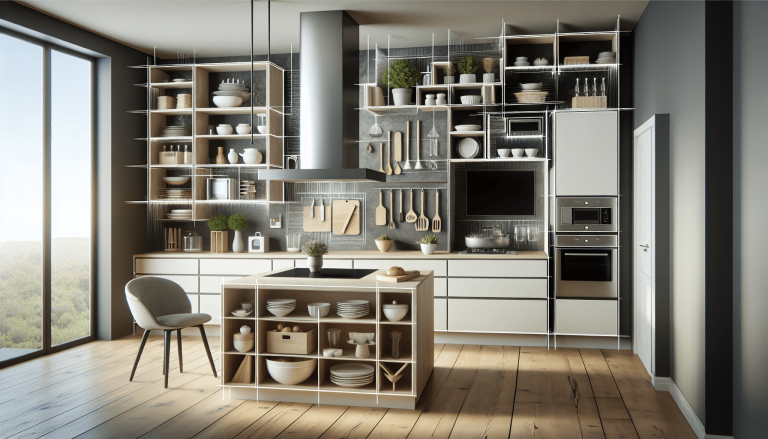If you’re looking to bring some greenery into your small living space, but are limited on floor space, a vertical garden may be just what you need. By utilizing vertical wall space, you can create a stunning garden that not only adds beauty to your home, but also maximizes the use of your small space. From hanging planters to living walls, there are many creative and practical ways to grow a vertical garden that will thrive even in the tightest of spaces. In this article, we will explore some simple yet effective tips and techniques on how you can successfully grow a vertical garden in a small space, allowing you to enjoy the benefits of nature’s beauty right at your fingertips.
Table of Contents
ToggleChoosing the Right Plants for a Vertical Garden
When it comes to creating a vertical garden in a small space, choosing the right plants is crucial. Consider the lighting conditions of your intended location. If your space receives limited sunlight, opt for plants that thrive in shady areas. On the other hand, if your vertical garden will be exposed to direct sunlight, choose plants that can tolerate heat and sunlight. Additionally, select compact and lightweight plants that won’t overwhelm your vertical garden structure. This will ensure that your plants can be easily supported and won’t cause strain on the structure.
Another important consideration is to choose plants with shallow roots. Since vertical gardens are typically grown in containers or pockets, plants with shallow roots will adapt well to this growing environment. Look for plants that have a compact root system and won’t require extensive soil depth. Finally, it’s essential to choose plants that grow well in containers. Not all plants are suitable for vertical gardening, so make sure to select varieties that have been successfully grown in containers or have trailing or climbing tendencies. This way, you can ensure that your vertical garden will flourish and thrive.
Determining the Location for Your Vertical Garden
Before you start building or purchasing a vertical garden structure, it’s important to determine the ideal location for your garden. Assess the available space you have, both vertically and horizontally. Vertical gardens can be installed on walls, fences, or even hanging structures, so make sure to choose a location that optimizes the use of space and complements your overall aesthetic vision.
Evaluate the access to natural light in your selected location. Most plants require a certain amount of sunlight to grow and thrive, so it’s crucial to choose a location that provides adequate lighting. Consider the duration and intensity of sunlight throughout the day. Is the location exposed to direct sunlight, or is it shaded for a significant portion of the day? This will help determine the types of plants that will thrive in your vertical garden.
Additionally, consider environmental factors such as wind exposure and temperature fluctuations. Some plants may not tolerate strong winds or extreme temperatures, so it’s important to choose a location that offers some protection from these elements. Finally, maximize vertical space by utilizing walls, trellises, or hanging structures. Think creatively and look for opportunities to make the most of the available space, both horizontally and vertically.
Building or Purchasing a Vertical Garden Structure
Once you have determined the location for your vertical garden, it’s time to decide whether you will build your own structure or purchase a pre-made one. Research different vertical garden structures to find one that suits your needs and fits well with your chosen location. Consider factors such as size, design, and the number of plants you want to grow.
If you have the necessary skills and tools, building your own vertical garden structure can be a rewarding DIY project. There are numerous online resources and tutorials available that provide step-by-step instructions for constructing different types of vertical gardens. However, if you prefer a hassle-free option, there are plenty of store-bought options available as well. These can range from simple hanging systems to more complex modular designs.
When choosing a vertical garden structure, consider the materials used and the durability of the product. Depending on the location of your garden, it may be exposed to moisture or extreme weather conditions, so selecting a structure made from weather-resistant materials is important. Additionally, ensure that the structure has proper irrigation and drainage systems in place. Adequate watering and drainage are essential for the health and longevity of your plants.
Preparing the Small Space for a Vertical Garden
Before installing your vertical garden, it’s important to prepare the small space properly to ensure optimal plant growth. Start by cleaning and decluttering the area. Remove any debris or obstructions that may interfere with plant installation or maintenance. This will help create a clean and organized space for your vertical garden.
Next, check for proper wall or ground stability. It’s essential to ensure that the surface where you will be installing your vertical garden can support the weight of the structure and plants. If you’re installing your garden on a wall, make sure it is structurally sound and able to bear the added weight. For ground installations, ensure that the soil is stable and won’t shift or erode over time.
If you’re installing a vertical garden on a wall, consider applying a waterproof barrier to protect the wall from moisture damage. This is especially important if the wall is made of materials that are susceptible to water penetration. A waterproof barrier, such as a sheet of plastic or a waterproof membrane, can help prevent water damage and prolong the life of your vertical garden.
Finally, ensure proper ventilation in your small space. Good airflow is important for preventing the buildup of excess moisture and for promoting healthy plant growth. Consider providing openings or vents in your vertical garden structure to allow for proper air circulation.
Choosing the Right Containers and Supports
When it comes to vertical gardening, selecting the right containers and supports is crucial for the success of your plants. Start by selecting containers with adequate drainage. Proper drainage is essential to prevent overwatering and root rot. Choose containers with drainage holes at the bottom or use pots with a built-in drainage system. This will allow excess water to escape, ensuring that your plants receive the right amount of moisture.
Consider the material and size of the containers. Plastic containers are lightweight and easy to move, making them a popular choice for vertical gardens. However, ceramic or terracotta pots can also add a touch of elegance to your garden. Choose a size that fits well within your vertical garden structure and allows enough space for plant growth.
When it comes to supports, it’s important to evaluate their stability and weight capacity. Vertical gardens can add significant weight to a structure, so make sure that the supports you choose are strong and sturdy. If you’re growing vining plants or climbers, consider utilizing trellises, stakes, or hanging baskets to provide additional support and guide their growth.
Preparing the Soil and Fertilizing the Plants
Proper soil preparation and fertilization are essential for the health and growth of your vertical garden plants. Use a lightweight and well-draining soil mix that will provide adequate moisture and nutrients to the plants. Avoid heavy soils that can retain excess moisture, as this can lead to root rot and other issues. Additionally, amend the soil with organic matter such as compost or aged manure to improve its fertility and water-holding capacity.
In addition to organic matter, consider using slow-release fertilizers to provide a steady supply of nutrients to your plants. Slow-release fertilizers release nutrients slowly over time, ensuring that your plants receive a balanced diet without the risk of over-fertilization. Additionally, you may also consider using liquid fertilizers to supplement the nutrient needs of your plants. Liquid fertilizers can be applied directly to the soil or foliar-sprayed onto the leaves for quick absorption.
Planting and Arranging the Vertical Garden
When it’s time to plant your vertical garden, careful planning and arrangement are key. Start by planning the arrangement and spacing of your plants. Consider the growth habits and mature sizes of each plant to ensure that they have enough space to develop properly. Proper spacing will also prevent overcrowding and competition for resources.
Install your plants in appropriate positions, taking into account their light and water requirements. Place shade-tolerant plants in areas with limited sunlight and sun-loving plants in areas that receive direct sunlight. Consider implementing techniques like intercropping or companion planting. Intercropping involves planting different species together to maximize space and resources. Companion planting involves planting compatible species that benefit each other by repelling pests or attracting beneficial insects.
Finally, consider aesthetics and color schemes when arranging your vertical garden. Choose plants with varying heights, textures, and colors to create an appealing visual display. Pay attention to the combination of foliage and flowers, and consider how these elements will blend together.
Regular Maintenance and Care
Regular maintenance and care are essential for the long-term success of your vertical garden. Establish a consistent watering routine based on the needs of your plants. Monitor the moisture levels of the soil and water accordingly. Be careful not to overwater or underwater your plants, as both can have detrimental effects on their health.
Additionally, monitor and control pests and diseases. Inspect your plants regularly for any signs of pest infestations or diseases. If necessary, take appropriate measures to control and prevent further damage. This can include using organic pest control methods, such as neem oil or insecticidal soap, or introducing beneficial insects that feed on pests.
Prune and trim your plants regularly to maintain their shape and encourage healthy growth. Remove dead or diseased foliage, and trim back any overgrown branches or vines. Regular pruning will also help improve airflow and prevent the spread of diseases.
Finally, ensure adequate nutrient levels for your plants. Monitor the growth and appearance of your plants and adjust fertilization as necessary. Use a balanced fertilizer or supplement with specific nutrients that your plants may require, such as iron or magnesium.
Harvesting and Utilizing Your Vertical Garden
Once your plants have matured, it’s time to reap the rewards of your hard work. Monitor the growth and maturity of your plants, and harvest fruits, vegetables, or herbs when they are ripe. Timing is crucial when it comes to harvesting, as different plants have different ripening periods. Harvesting at the right time will ensure the best flavor and quality of your produce.
Explore creative recipes and culinary uses for the fruits, vegetables, or herbs from your vertical garden. Whether it’s adding fresh herbs to your favorite dishes, using homegrown vegetables in salads, or preserving fruits for future use, there are endless possibilities for using the bounty from your vertical garden in the kitchen.
Additionally, consider sharing or donating surplus produce. If your vertical garden produces more than you can consume, consider sharing the harvest with friends, family, or neighbors. You could also donate the surplus produce to local food banks or community organizations. Not only will this help reduce waste, but it will also contribute to a sense of community and sharing.
Tips and Tricks for Maximizing a Vertical Garden’s Potential
To maximize the potential of your vertical garden, consider these tips and tricks. Utilize reflective surfaces to increase the amount of light reaching your plants. This can be achieved by placing mirrors strategically around the garden or using materials with reflective properties.
Implement vertical planters or pocket systems to maximize space. These specifically designed systems allow you to grow plants in small pockets or modules, effectively utilizing every inch of vertical space available. Look for innovative designs that provide easy access to plants for maintenance and harvesting.
Utilize vertical gardening accessories such as plant ties, clips, or hooks. These tools can help support and train your plants to grow vertically, preventing them from sprawling or taking up too much space. Experiment with different accessories to find the ones that work best for your specific plants and garden structure.
Finally, don’t be afraid to experiment and learn from experience. Vertical gardening is a unique and dynamic gardening method that requires a bit of trial and error. Observe the growth and development of your plants, learn from any challenges you may encounter, and make adjustments accordingly. By constantly experimenting and adapting, you’ll be able to optimize your vertical garden and enjoy the rewards it brings.
With the right plants, proper location, suitable structure, adequate preparation, suitable containers and supports, appropriate soil and fertilization, thoughtful planting and arrangement, regular maintenance and care, strategic harvesting and utilization, and a few tips and tricks, you can grow a thriving and beautiful vertical garden in even the smallest of spaces. Enjoy the process and embrace the beauty and bounty that vertical gardening can bring to your life!









